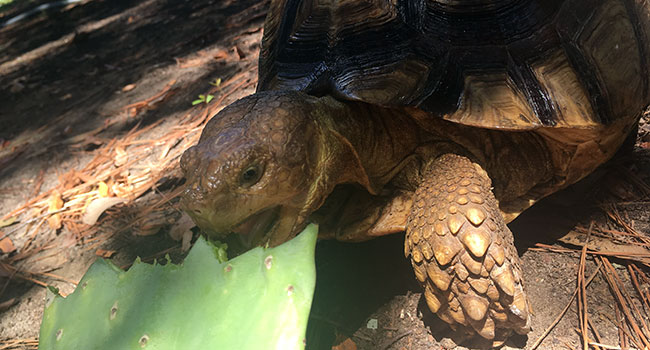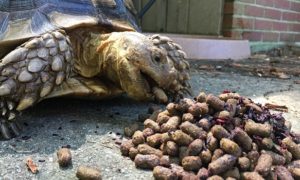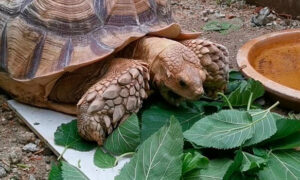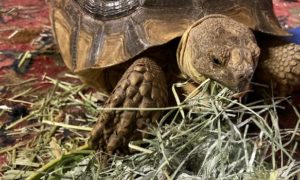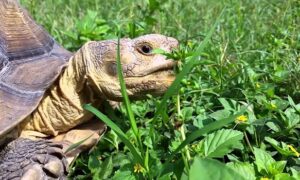Cactus is a great treat for sulcata tortoises. You don’t want to make it a staple in your sulcata’s daily diet, but you can feed your tortoise cactus.
Benefits of Cactus for Tortoises
Cactus is high in calcium AND fiber! Both are very beneficial to your tortoise’s overall health and diet.
Plus, cactus pads are high in water content, so during the hotter days of summer, cactus pads serve as a refreshing treat.
What Part of the Cactus Can Sulcata Tortoise Eat?
Your sulcata tortoise can eat the entire cactus – pads, flowers and fruit.
Cactus Fruit and Flowers
Feed cactus fruit sparingly. Although, it is safe for sulcata tortoises to eat, the fruit is high in sugar. Too high sugar content can overtime cause health problems. A diet high in sugar, can actually make ideal conditions in the intestines for parasites to thrive. This is why fruit should be sparing.
The flowers are not as high in sugars, but are best offered occasionally.
Cactus Pads
If the cactus pad has spines, you’ll want to remove the spines. Although, your tortoise can eat the spines, it’s easier if you remove them, especially if the spines are hard and prickly.
Some cactus plants, like spineless opuntia cactus, have tiny, fine hair spines that you don’t have to remove.
What Type of Cactus Can a Sulcata Eat?
The most preferred type of cactus that sulcata tortoises can eat is spinless opuntia cactus.

But, there are other types of cactus that you can offer a sulcata tortoise.
Safe Cactus for Sulcatas
- Aeonium
- Broadleaf Stonecrop
- Echeveria (Hens and Chicks)
- Gasteria
- Haworthia
- Heartleaf Iceplant (Baby Sun Rose; Aptenia)
- House Leek (Sempervivum; Hens and Chicks)
- Ice Plant (Sedum spectiable; Hylotelephium spectabile)
- Mother of Pearl Plant (Ghost Plant, Dream Plant, Leatherpetal, Mother-of-Pearl Plant)
- Opuntia Cactus (Prickly Pear)
- Rhipsalis (Mistletoe Cactus)
- Sedum (Stonecrop)
- Sedum Album (White Stone Crop)
- Sedum Reflexum
- Sedum Spurium (Dragon’s Blood Sedum, Tricolor Stonecrop, Two Row Stonecrop)
Feed in Moderation
- Christmas Cactus
- Easter Cactus
- Hottentot Fig (Ice Plant, Iceplant, Pigface) Carpobrotus edulis
- Ice Plant (Iceplant, Trailing Ice Plant, Dew Flower) Delosperma spp.; Lampranthus spp.; Drosanthemum spp.
- Jade Plant (Friendship Tree, Money Plant, Money Tree, Crassula Ovata) Crassula ovata; Crassula argentea; Crassula portulacea
- Pachyphytum Bracteosum
- Red Pitaya (Dragonfruit, Hylocereus)
Feed Sparingly
- Agave (Century Plant)
- Aloe (Aloe Vera)
Bad Cactus for Tortoises
Not all cactus is safe for tortoises. Some contain carcinogenic properties, which can cause inflammation of the skin and eye, nose and mouth. Typically, these types of cactus or succulents have a milky sap. Other plants contain a cardiac glycosides that can cause cardiac poisoning in mammals, so it’s advised to avoid consuming in general.
Do not feed a sulcata tortoise the following cactus.
- Euphorbia
- Flaming Katy
- Mother of Thousands (Mexican hat, Chandelier Plant, Devils Backbone, Alligator Plant)
- Paddle Plant (Flapjack Plant, Red Lips, Kalanchoe, Desert Cabbage)
- Panda Plant (Chocolate Soldier, Felt Bush)
- Sedum Acre (Biting Stonecrop, Gold Moss)
How to Feed Cactus to Sulcata Tortoise
Keep in mind that the larger the cactus pad, the tougher it is. So, for baby sulcata tortoises, offer the smaller pads that are a lighter shade of green. If you only have larger pads available, you can chop up the pad into slivers. Remove the skin before giving it to the tortoise.
For larger tortoises, you can offer the cactus pad as is.
If you have a cactus pad with spines, you can cut off the spines before giving it to your tortoise.

